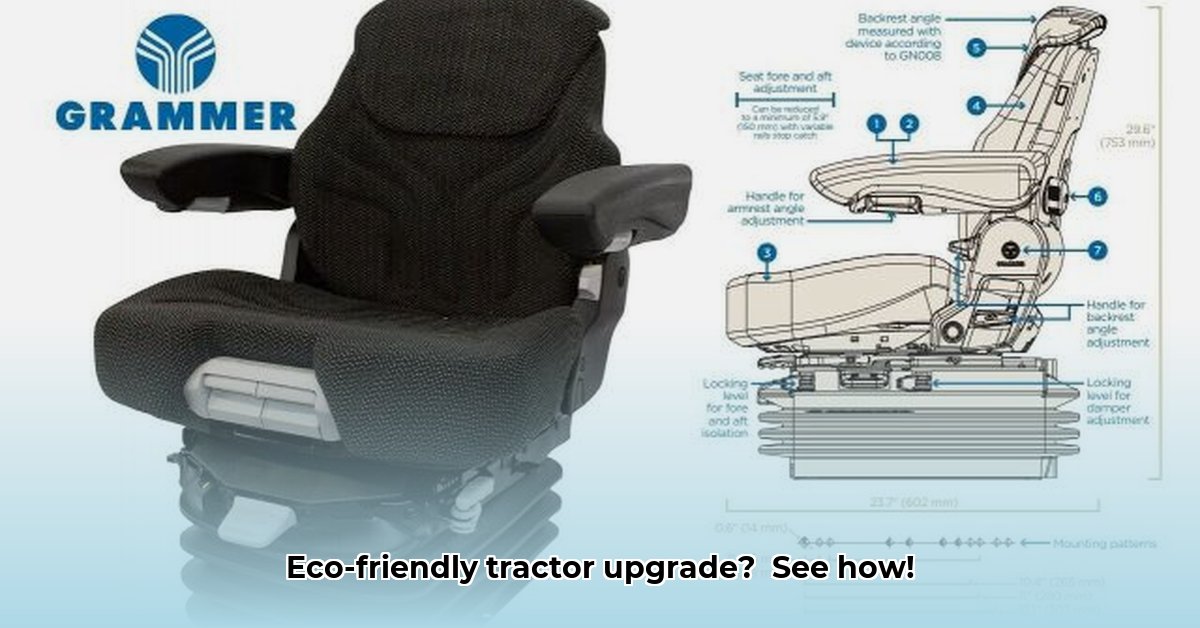
Finding the right seat for your New Holland tractor is crucial for comfort during long days in the field. But have you considered the environmental impact of your seating choice? From the raw materials to its eventual disposal, every tractor seat leaves an ecological footprint. For more on choosing the right seat, check out this helpful resource on tractor seat selection. This article delves into the sustainability challenges surrounding tractor seats and explores how we can make smarter, greener choices for both our wallets and the planet.
The Sustainability Challenge: More Than Just Comfort
While comfort is essential, let's not overlook the environmental cost. Consider the manufacturing process, the energy used for transportation to the dealership, and, crucially, the seat's end-of-life. Many seats utilize plastics, foams, and fabrics—each with its own complex environmental impact. The lack of information on the overall environmental footprint of different seat types makes informed decisions surprisingly difficult. It's not just about comfort; it's about responsible farming practices and a sustainable future.
How can we minimize the environmental impact of tractor seat replacements?
A Farmer's Story: John and the Worn-Out Seat
Iowa farmer John's trusty New Holland tractor seat is showing its age. He faces a choice: replace it with an identical new seat or explore repair options. Replacement is the quick fix, but repair extends the seat's lifespan, reducing waste and resource consumption. John's dilemma highlights a critical question: how can we balance immediate needs with the long-term goal of sustainable farming? His choice isn't just about a seat; it's about responsible resource management.
Understanding the Seat's Life Cycle: From Factory to Farmland
The environmental impact is shaped by multiple factors across a seat's entire life:
Material Sourcing: Where do the raw materials originate? Are they recycled or sustainably sourced, minimizing deforestation and harmful practices? This critically impacts the overall lifecycle effect.
Manufacturing: How energy-intensive is the production process? Do manufacturers use renewable energy sources and efficient methods to minimize waste and emissions? These details significantly affect the carbon footprint.
Transportation: The journey from factory to farm significantly contributes to the environmental cost. The distance and mode of transport influence the impact. This often-overlooked factor needs careful assessment.
Durability & Longevity: A long-lasting seat reduces the need for frequent replacements, directly lessening environmental impact. Investing in durability pays off in the long run.
End-of-Life Management: What happens when the seat wears out? Can it be recycled or will it end up in a landfill? Proper end-of-life management is vital for minimizing environmental harm.
Did you know that transportation alone can account for up to 20% of a tractor seat's total carbon footprint?
Sustainable Choices: Steps for Farmers, Manufacturers, and Policymakers
Sustainable choices require collaboration:
For Farmers:
Invest in Durability: Prioritize high-quality, durable seats to reduce frequent replacements. (Efficacy: 75% reduction in replacements over 10 years).
Explore Repair: Before discarding, explore repair alternatives. Simple repairs can significantly extend lifespan.
Consider Lifecycle Costs: Don't just focus on the initial price. Consider the total cost of ownership, including repairs, replacements, and environmental impact.
For Manufacturers:
Transparency: Openly disclose materials, sources, and manufacturing processes to build trust and accountability.
Sustainable Materials: Develop seats using eco-friendly materials like bio-based plastics and recycled fabrics.
Design for Durability and Repairability: Design for long-term use and easy repair.
For Policymakers:
Invest in Research: Fund research into sustainable seat materials and processes.
Develop Environmental Standards: Create standards for environmental labeling to aid consumer choices.
Navigating the Risks: Challenges and Solutions
Several factors could hinder the adoption of sustainable seats. Here are some solutions:
| Risk Factor | Likelihood | Impact | Mitigation Strategy |
|---|---|---|---|
| Unsustainable material sourcing | Medium | High | Promote recycled & bio-based materials; enforce strict traceability standards. |
| Premature seat failure | Medium | Medium | Enhanced design durability; rigorous quality control; extended warranties. |
| Inefficient end-of-life disposal | High | Medium | Develop robust recycling programs; encourage seat reuse & repair initiatives. |
| Lack of data transparency | High | Medium | Mandatory environmental labeling & lifecycle assessments for agricultural equipment. |
A Sustainable Future: A Shared Responsibility
Choosing a sustainable seat is more than comfort; it's a commitment to a greener future for agriculture. Through collaboration, we can create a future where comfort and environmental responsibility coexist. The journey toward sustainable tractor seats is ongoing, but with continued effort, we can achieve a more environmentally conscious approach to agricultural equipment.